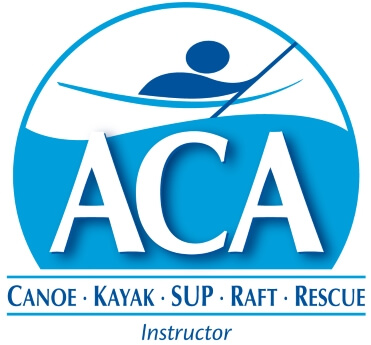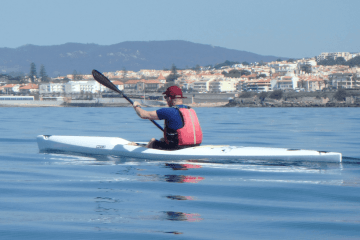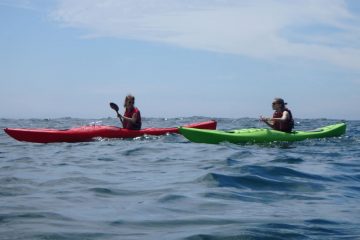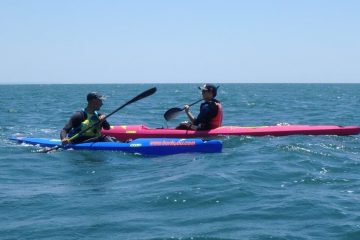We are the only Portuguese organization to be certified by the American Canoe Association and here you can take the Level II Course. The Course is designed to teach beginner paddlers to safely and enjoyably kayak on lakes, calm protected ocean environments, and other flatwater settings. On this level, you can choose the modality that fits you better.
You’ll learn the fundamentals of kayaking, from paddling corrections to maneuvers and rescue techniques, and you’ll be able to achieve a worldwide recognized certificate.
Our instructors are certified by the ACA to teach all the contents of the Sea Kayak Courses.
The course consists of 10 modules which you can access in the contents tab to see more detailed information. If you want to be certified by the ACA, you need to take a practical exam where you must complete the minimum requirements to pass and obtain certification.
This is the beginning of many adventures that await you. You’ll surely be ready to join various expeditions inside and outside Portugal (including ours!) and ready to paddle between rivers and seas with magnificent landscapes.
Prices
| SKILLS + ASSESSMENTS | 420€ |
| SKILLS* | 300€ |
| ASSESSMENTS | 180€ |
*You can take the course with just the skills, but if you want certification afterwards it will cost extra.
| DEPARTURE/RETURN LOCATION | BORK Store, Oeiras Marina |
| DEPARTURE TIME | Please arrive 10 minutes before session start. |
| RETURN TIME | Approximately 3 hours/ session. |
| WEAR | Bring a swimming suit, hat and sunscreen. |
Essentials of kayak touring
The course is certified by the American Canoe Association and given by certified instructors who will teach you the basics of coastal kayaking so that you can go further.
We run complete workshops all year long as we have a mild climate.
You might also want to improve specific skills before you take the examination. Here’s the course overview.
The main skills you will learn are the following:
- Introduction, Expectations, and Logistics:
Welcome, introductions, paperwork;
Student and instructor course expectations and limitations;
Course itinerary and site logistics;
Review waiver, assumption of risk, challenge by choice, medical disclosure;
About the ACA;
Lifejacket (PFD) policy (always wear on water);
Appropriate personal behavior;
No alcohol / substance abuse;
Proper etiquette on and off the water;
Respect private property;
Practice Leave No Trace ethics.
- The Paddling Environment:
Wind;
Waves;
Weather;
Water.
- Personal Preparation:
Personal ability;
Swimming ability;
Water comfort and confidence;
Fitness, conditioning, and warm up;
Safe paddle and boat handling;
Safety and rescue considerations;
Personal equipment (reviewed by Instructor).
- Equipment
Lifejackets (PFDs): types, fit;
Kayaks: types, parts, backbands and safety gear such as pumps;
Paddles: types, materials, parts, length, blade size, shape and offset, hand position;
Care of equipment;
Personal equipment: water, food, shoes, hat, sunscreen, insect repellent, sun glasses, eyeglass straps, protective clothing for heat or cold, sponge, bailer/pump, whistle (or other approved sounding device), knife, light;
Optional equipment and outfitting for improved control, thigh braces.
- Getting Started
Warm-up and stretching;
How to pick up and carry a kayak safely;
Car topping: loading and unloading, racks, straps;
Launching and landing;
Boarding, three points of contact, weight kept low, etc;
Posture, safety, comfort, effectiveness, rocking, balance;
Wet exits;
Water comfort and confidence;
Self-rescue;
Basic Terminology;
Types of strokes (covered in this course): power, turning, support;
Stroke components: catch, propulsion, recovery (CPR), control, correction;
Safe and effective body usage. - Safety and Rescue
Exercising judgment, safety as a mind-set, etc;
Hypothermia/ cold immersion shock: help/huddle, clothing;
Dehydration/ hyperthermia: hydration, clothing;
Hazards: wind, waves, weather, current, rocks, bridges, piers, dams, strainers, traffic;
Paddling as a group;
Signaling;
Interactions/ sharing water with non-powered and powered traffic;
Emergency procedures. - Rescue
Rescue sequence: RETHROG (reach, throw, row, go);
Rescue priorities: people, boats, gear;
Demonstrate/participate: Deep- water re-entries, assisted and solo;
Boat assisted rescue, assisting a tired swimmer (pushing or pulling to shore);
T-X rescue (blown hatch rescue) w/ pump;
Towing or bulldozing a capsized boat. - Strokes
Forward;
Back (stopping);
Draw;
Sweep (forward and reverse);
Rudder (stern);
Low brace;
Low brace turn. - Maneuvers
Paddling in a reasonably straight line;
Spins;
Stopping;
Moving abeam (sideways). - Conclusion and Wrap Up
Group debrief / individual feedback;
Course limitations;
Importance of first aid and CPR;
Importance of additional instruction, practice, experience;
Importance of appropriate level of safety and rescue training;
Demonstrate advanced maneuvers;
Life sport / paddling options;
Local paddling groups / clubs;
Handouts / reference materials;
ACA membership forms;
Course evaluation;
Participation cards.
Essentials of kayak touring
The course is certified by the American Canoe Association and given by certified instructors who will teach you the basics of coastal kayaking so that you can go further.
We run complete workshops all year long as we have a mild climate.
You might also want to improve specific skills before you take the examination. Here’s the course overview.
The main skills you will learn are the following:
- Introduction, Expectations, and Logistics:
Welcome, introductions, paperwork;
Student and instructor course expectations and limitations;
Course itinerary and site logistics;
Review waiver, assumption of risk, challenge by choice, medical disclosure;
About the ACA;
Lifejacket (PFD) policy (always wear on water);
Appropriate personal behavior;
No alcohol / substance abuse;
Proper etiquette on and off the water;
Respect private property;
Practice Leave No Trace ethics. - The Paddling Environment
Wind;
Waves;
Weather;
Water. - Personal Preparation:
Personal ability;
Swimming ability;
Water comfort and confidence;
Fitness, conditioning, and warm up;
Safe paddle and boat handling;
Safety and rescue considerations;
Personal equipment (reviewed by Instructor);
Learning judgment. prudent behavior, being aware of what you do not know, cannot handle, or should not risk;
Group equipment: extra paddle, dry bags, first aid kit and rescue equipment (depending on the environment and nature of the trip this may include cell phones, 2- way radios, vhf radios, paddle floats, rescue slings, etc.);
Guidebooks, maps/charts, local knowledge;
Assessing relevant existing and approaching environmental conditions including: tides, weather, time of day, water and air temperature, traffic, and accessibility;
Assessing personal and group dynamics (skills, equipment, group makeup, emotional concerns, logistics, and leadership);
Filed trip plan. - Getting Started:
Warm-up and stretching;
How to pick up and carry a kayak safely;
Car topping: loading and unloading, racks, straps;
Launching and landing;
Boarding, three points of contact, weight kept low, etc;
Posture, safety, comfort, effectiveness, rocking, balance;
Spray skirts;
Water comfort and confidence: wet exits – capsize & effectively exit;
Wet exits in two ways: (1) utilizing the spray skirt grab loop and (2) releasing the skirt off
the hip;
Self-Rescue;
How to empty a kayak;
Basic terminology;
Types of strokes (covered in this course): power, turning;
Stroke components: catch, propulsion, recovery (CPR), control, correction;
Safe and effective body usage. - Equipment:
Lifejackets (PFDs): types, fit;
Kayaks: types, materials, parts (including safety features such as flotation);
Paddles: types, materials, parts, length, blade size, shape and offset, hand position;
Care of equipment;
Personal equipment: water, food, shoes, hat, sunscreen, insect repellent, sun glasses, eyeglass straps, protective clothing for heat or cold, sponge, bailer/pump, whistle (or other approved sounding device), knife, light;
Optional equipment and outfitting for improved control. - Safety and Rescue:
Exercising judgment, safety as a mind-set, etc;
Cold water shock / hypothermia: HELP / huddle, clothing;
Dehydration/ hyperthermia: hydration, clothing;
Hazards: wind, waves, weather, current, rocks, bridges, piers, dams, strainers, traffic;
Paddling as a group;
Signaling;
Interactions/ sharing water with non-powered and powered traffic;
Emergency procedures. - Rescue
Rescue sequence: reach, throw, row, go (RETHROG);
Rescue priorities: people, boats, gear;
Demonstrate/participate: T-rescue;
Deep-water re-entries, assisted and solo, with sling, including scoop and paddle float rescues;
Boat assisted rescue, assisting a tired swimmer (pushing or pulling to shore);
Towing or bulldozing a capsized boat. - Maneuvers:
Paddling in a reasonably straight line;
Spins;
Stopping;
Moving abeam (sideways). - Strokes:
Forward;
Back (stopping);
Draw;
Sculling draw;
Sweep (including stern draw);
Reverse sweep;
Stern rudder;
Low brace;
Low brace turn. - Conclusion and Wrap Up:
Group debrief / individual feedback;
Course limitations;
Importance of first aid and CPR;
Importance of additional instruction, practice, experience;
Importance of appropriate level of safety and rescue training;
Demonstrate advanced maneuvers;
Life sport / paddling options;
Local paddling groups / clubs;
Handouts / reference materials;
ACA membership forms;
Course evaluation;
Participation cards.








